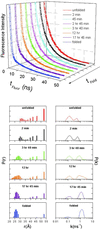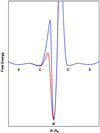Using deeply trapped intermediates to map the cytochrome c folding landscape
- PMID: 12084923
- PMCID: PMC124336
- DOI: 10.1073/pnas.132254499
Using deeply trapped intermediates to map the cytochrome c folding landscape
Abstract
Replacement of iron with cobalt(III) selectively introduces a deep trap in the folding-energy landscape of the heme protein cytochrome c. Remarkably, neither the protein structure nor the folding thermodynamics is perturbed by this metal-ion substitution, as shown by data from spectroscopic and x-ray diffraction experiments. Through kinetics measurements, we have found parallel folding pathways involving several different misligated Co(III) species, and, as these folding intermediates persist for several hours under certain conditions, we have been able to elucidate fully their spectroscopic properties. The results, along with an analysis of the fluorescence energy-transfer kinetics during refolding, show that rapidly equilibrating populations of compact and extended polypeptide conformations are present until all molecules have reached the native structure. These measurements provide direct evidence that collapsed denatured structures are not substantially more stable than extended conformations of cytochrome c.
Figures





References
-
- Onuchic J N, Nymeyer H, Garcia A E, Chahine J, Socci N D. Adv Protein Chem. 2000;53:87–152. - PubMed
-
- Portman J J, Takada S, Wolynes P G. J Chem Phys. 2001;114:5069–5081.
-
- Portman J J, Takada S, Wolynes P G. J Chem Phys. 2001;114:5082–5096.
-
- Özkan S B, Bahar I, Dill K A. Nat Struct Biol. 2001;8:765–769. - PubMed
-
- Mirny L, Shakhnovich E I. Annu Rev Biophys Biomol Struct. 2001;30:361–396. - PubMed
Publication types
MeSH terms
Substances
Associated data
- Actions
LinkOut - more resources
Full Text Sources
Molecular Biology Databases

